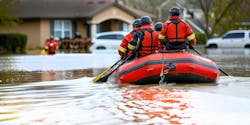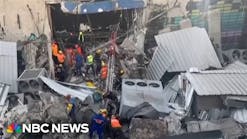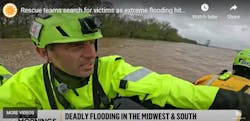Placards and labels must remain in place until the material is used up and the container is purged of the residue. There are also other fixed storage and use marking systems, including the National Fire Protection Association (NFPA) 704 system, OSHA Hazard Communication Systems, and miscellaneous internal marking systems for occupancies, which store and use hazardous materials.
Photo by Robert Burke NFPA 704 diamonds displayed on the front gate indicate the presence of multiple hazardous materials at this compressed gas facility.
Work on the development of NFPA 704 started in 1952, resulting in the establishment of the standard in 1957. This system was one of the first efforts to identify locations where hazardous materials were stored and used, but does not apply to transportation. DOT did not develop its system for transportation marking for another 20 years. Because 704 is a standard, it is not required or mandated unless a local jurisdiction adopts the standard and makes it law within the community. Usage of 704 varies from community to community. Some facilities may place 704 diamonds on buildings and locations where hazardous materials are stored or used voluntarily, so it is possible 704 diamonds could be found even in communities where it has not been adopted or required by law.
NFPA 704 is a generic marking system designed to alert emergency responders to the presence of hazardous materials at a particular occupancy, to assist them in evaluating the hazards present, and to help them in planning effective fire and emergency control operations. NFPA 704 does not provide specific information about individual chemicals. The information won't provide chemical names. It is a basic identification system to help first-responding emergency personnel decide whether to evacuate the area or to commence control procedures. It also assists responders with selection of firefighting tactics, appropriate personal protective equipment (PPE) and emergency procedures.
NFPA 704 is intended to provide information to emergency responders about the general hazards of materials that may be inside an occupancy. The hazards on a diamond do not provide information about every hazardous material in a facility. NFPA 704 diamonds list the most severe hazards of the most hazardous chemicals present. They are really only a "stop" sign to warn responders and to make them aware of hazardous materials present. Information provided will not indicate routes of entry for toxic materials, degrees of radioactivity, corrosivity or other specific chemical information. More information will be needed before mitigation efforts are undertaken.
NFPA 704 diamonds are placed on the outside of buildings near the entrances or addresses on the buildings. They may also be placed on the inside of the building where the hazardous materials are stored and used. Exact locations are left up to the Authority Having Jurisdiction (AHJ), but minimum requirements in the standard require the following locations:
- Two exterior walls or enclosures containing a means of access to a building or facility
- Each access to a room or area
- Each principal means of access to an exterior storage area
Photo by Robert Burke The NFPA 704 diamond is displayed along with a DOT flammable gas placard on a propane tank located at a gasoline station. The NFPA 704 marking system alerts emergency responders to the presence of hazardous materials.
Diamonds used on the outside of buildings are generally a minimum size of 15 by 15 inches. Those used inside of the building are a minimum of 10 by 10 inches. Smaller diamonds may be found on individual containers. NFPA 704 placards are divided into four colored quadrants, or four "mini" diamonds within the larger diamond. The upper quadrant at the "12 o'clock" position is red, followed by blue at "9 o'clock" to the left, yellow at "3 o'clock" to the right and the bottom is white at the "6 o'clock" position.
Hazard Indicators
Each color designates a specific hazard. Red indicates flammability, blue health, yellow instability and white special information. Special information located in the white quadrant listed in the 704 standard includes materials that react violently or explosively with water, represented by a W with a slash through it, and OX for materials with oxidizing properties. The standard lists specific criteria for these symbols to be included on the diamond in the appendix.
Other users of the 704 system have added other symbols, which are not a part of the 704 standard and include RAD for radioactive, COR indicating corrosive, UD is unclassified detonable, 4D Class 4 detonable, 3D Class 3 detonable, and 3N non-detonable. The NFPA 704 standard is not intended to speak to the following hazardous situations:
- Occupational exposures
- Explosive and blasting agents, including commercial explosives
- Chemicals whose only hazard is as a chronic health hazard
- Teratogens, mutagens, oncogens, etiologic agents and other similar hazards
Numbers are placed within the quadrants of the 704 diamond indicating the degree of hazard posed by an individual chemical or as quoted in the standard, "according to the ease, rate, and quantity of energy release of the material in pure or commercial form." The numbers used to identify the range of hazard are from 0 to 4, with 0 indicating no particular hazard and 4 indicating the most severe hazard or most energy release.
Degrees of hazard associated with health, flammability and instability are determined by criteria outlined in the standard. Some jurisdictions may place a letter G in the quadrant with the number to indicate the presence of a compressed gas.
Health Hazards
Health hazards are ranked according to the level of toxicity and effects of exposure to response personnel. They are based on short-term, acute exposure during handling under conditions of spill, fire or similar emergencies. Short-term exposure ranges from minutes to hours. Acute exposures typically are sudden and severe and characterized by rapid absorption of the chemical that is quickly circulated through the body and damages one or more vital organs. Acute effects include severe burns, respiratory failure, coma, death or irreversible damage to a vital organ.
(The following guidelines are my effort to explain the material in NFPA 704 in terms of protection of response personnel. They are not intended to be recommendations. Materials at the scene of a hazardous materials incident should be thoroughly researched and decisions made by those on scene as to the appropriate level of protection responders should wear based upon the hazards present. Specific details of criteria used to determine hazard numbering is located in the NFPA 704 standard.)
- 4 - Materials that can be lethal if response personnel do not wear proper chemical protective equipment. If gases or skin-absorbent gases, liquids or solids, Level A chemical protection would be necessary. Firefighter turnouts would not provide appropriate protection. Examples of Health Hazard 4 chemicals include chlorine, phosgene, hydrocyanic acid (hydrogen cyanide), hydrogen sulfide, phenol, phosphine, pentaborane and acrylonitrile (vinyl cyanide).
- 3 - Materials that can cause serious or permanent injury. Level A chemical protection or Level B chemical protection would be appropriate depending on the physical state of the hazardous materials. Firefighter turnouts would not provide appropriate protection. Examples of Health Hazard 3 include anhydrous ammonia, acetaldehyde, acrylic acid, carbon monoxide, formic acid, pyridine, nitric acid and para xylene (p-xylene).
- 2 - Materials that can cause temporary incapacitation or residual injury. Level B or Level C chemical protection would be appropriate for these chemicals. Firefighter turnouts would likely not provide appropriate levels of protection. Health Hazard 2 chemicals include meta and ortho xylene (m-xylene and o-xylene), toluene, styrene, ethyl formate, benzene, 1,1,1-trichloroethane and vinyl chloride.
- 1 - Materials that can cause significant irritation. Level C chemical protection would likely be appropriate protection. Firefighter turnouts may provide some protection, particularly respiratory. Many irritants are actually solid materials and may contaminate personnel. Remember that firefighter turnouts are not classified as chemical protective clothing. Health Hazard 1 chemicals include, acetone and butane.
- 0 - Materials that would offer no hazard beyond that of ordinary combustible materials. Firefighter turnouts would provide appropriate protection for personnel.
Flammability Hazards
Flammability hazards are based upon a material's susceptibility to burning. Conditions present need to be considered as well as the combustibility characteristics of the fuel. Firefighter turnouts are generally the appropriate protective clothing for flammability hazards. There may, however, be conditions where firefighters even in full turnouts cannot be adequately protected because of the volume of fire or flame impingement on containers. Each situation needs to be thoroughly evaluated based upon the flammability hazards present. Some flammable chemicals may also be toxic, and toxicity should be taken into account before emergency personnel are sent into a scene where toxic materials may be present or on fire.
- 4 - Materials that are flammable gases, flammable cryogenics or liquids with flash points below 73 degrees Fahrenheit and boiling points below 100F, (Class IA liquids). Also included are gases, liquids and solids that may spontaneously ignite when exposed to air. Examples of Flammable Hazard 4 chemicals include hydrogen, acetylene, vinyl chloride, trichlorosilane, propylene oxide, picric acid, phosphorus, natural gas, hydrogen cyanide, formaldehyde gas, ethylene oxide, carbon disulfide, carbon monoxide and ethyl ether.
- 3 - Liquids having a flash point below 73F and having a boiling point at or above 100F. Liquids having a flash point at or above 73F and a boiling point at or above 100F (Class IB and Class IC liquids). Also included are solid materials that because of their physical form can form explosive mixtures when suspended in air. Examples of Flammable Hazard 3 liquids and solids include acetonitrile (methyl cyanide), acrolein, aluminum powder, benzene, gasoline, calcium carbide, methyl isocyanate and potassium.
- 2 - Liquids having a flash point at or above 100F but below 200F (Class II and Class IIIA liquids). Solid materials that burn rapidly but do not form explosive mixtures with air. Flash point solids, which give off flammable vapors. Examples of Flammability Hazard 2 liquids and solids include glacial acetic acid, cresols, lithium aluminum hydride, nitrobenzene and phenol.
- 1 - Chemicals that will burn in air when exposed to temperatures above 1,500F for five minutes. Liquids and solids which have a flash point at or above 200F (Class IIIB liquids). Most ordinary combustible materials. Examples of Flammability Hazard 1 materials include trichloroethylene, polychlorinated biphenyls, phosphorus pentasulfide, paraformaldehyde, methyl bromide, magnesium and anhydrous ammonia.
- 0 - Materials which generally will not burn under normal circumstances.
Instability Hazards
Instability hazards (reactivity) addresses the degree of inherent vulnerability of materials to release energy. It applies to materials capable of rapidly releasing energy by themselves, through self-reaction or polymerization. It does not deal with water-reactive materials. Organic peroxides need to be evaluated with NFPA 432 Code for the Storage of Organic Peroxide Formulations.
Instability does not take into account the unintentional combination of materials, which may occur during fire or other conditions. During storage, unintentional mixing should be considered in order to establish appropriate separation or isolation. The degree of instability hazard is meant to indicate to emergency personnel if an area should be evacuated, if firefighting should be conducted from a location of cover, if caution is required when approaching for extinguishment, based upon extinguishing agent, or if a fire can be fought using normal procedures. Ranking of instability hazards is based upon a materials ease, rate and quantity of energy release.
- 4 - Materials sensitive to shock and heat at normal temperatures and pressures. Can undergo detonation or explosive decomposition at normal temperatures and pressures. Examples of Instability Hazard 4 include ammonium perchlorate, 3-bromopropyne, chlorodinitrobenzenes, fluorine, nitromethane, peracetic acid and picric acid.
- 3 - Materials sensitive to shock and heat at elevated temperatures and pressures. Subject to detonation or explosive decomposition or explosive reaction, but need a strong initiating source or must be heated under confinement. Examples of Instability Hazard 3 include, tetrafluoroethylene, silane, n-propyl nitrate, perchloric acid, nitroethane, hydrogen peroxide greater than 60%, hydrazine, ethylene oxide, chloropicrin and ammonium nitrate.
- 2 - Chemicals which will undergo violent chemical change at elevated temperatures and pressures. Examples of Instability Hazard 2 chemicals include trichlorosilane, titanium tetrachloride, sulfuric acid, styrene monomer, sodium hydride, potassium, phosphorus trichloride, phosphorus, methyl isocyanate, hydrogen cyanide, ethylene, epichlorohydrin and aluminum chloride.
- 1 - Materials that in themselves are normally stable, but that can be come unstable at elevated temperatures and pressures. Examples of Instability Hazard 1 materials include acetic anhydride, allyl alcohol, aluminum powder, ethyl ether, hydrogen chloride, magnesium, nitrobenzene, phosgene and potassium hydroxide.
- 0 - Materials that in themselves are normally stable, even under fire conditions.
Special Hazards
Special hazards listed in the text of NFPA 704 are limited to water reactive and materials with oxidizing properties that require special firefighting techniques. Special hazards are indicated by a symbol located in the quadrant of the diamond at the "6 o'clock" position in the white section. Materials that react violently or explosively with water are identified by the letter W with a line through the center. Materials that possess oxidizing properties are identified by the letters OX. Examples of chemicals with an OX hazard include sodium peroxide, potassium peroxide, peracetic acid, oxygen, nitric acid, hydrogen peroxide, chromic acid, bromine and ammonium nitrate. Water-reactive materials include calcium carbide, calcium hypochlorite, fluorine, lithium aluminum hydride, potassium and sodium.
NFPA 704 is just one of many tools available for emergency responders when evaluating an incident scene for the presence of hazardous materials. More information needs to be gathered before mitigation tactics are decided upon. Generally, firefighter turnouts do not provide much protection against hazardous materials, although self-contained breathing apparatus (SCBA) provides a high-level of respiratory protection. A thorough evaluation of the hazards present along with a risk/benefit analysis must take place before personal protective equipment (PPE) and tactics are selected.
Robert Burke, a Firehouse® contributing editor, is the fire marshal for the University of Maryland. He is a Certified Fire Protection Specialist (CFSP), Fire Inspector II, Fire Inspector III, Fire Investigator and Hazardous Materials Specialist, and has served on state and county hazardous materials response teams. Burke is a veteran of 24 years in fire and emergency services, with experience in career and volunteer departments. He has attained the rank of lieutenant, assistant chief and deputy state fire marshal. Burke is an adjunct instructor at the National Fire Academy and the Community College of Baltimore, Catonsville Campus, and the author of the textbooks Hazardous Materials Chemistry for Emergency Responders and Counter-Terrorism for Emergency Responders. He can be reached in the Internet at [email protected].






